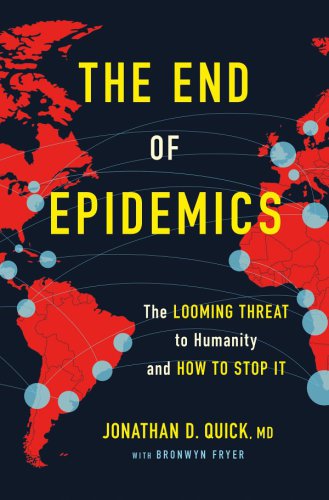
The End of Epidemics
The Looming Threat to Humanity and How to Stop It
- اطلاعات
- نقد و بررسی
- دیدگاه کاربران
نقد و بررسی

November 13, 2017
Quick, a senior fellow at Management Sciences for Health, and Fryer, a former senior editor for the Harvard Business Review, lay out a seven-step action plan for stopping epidemics in this informative, if stiff, treatise. The plan is based on their analysis of global response to five epidemics (smallpox, influenza, AIDS, SARS, and Ebola), which have killed more than 500 million people over the last century. The authors urge nations to learn from past mistakes in dealing with killer diseases and to make pandemic prevention a global priority. They argue that this can be accomplished by developing a worldwide early warning system and a network of response teams. Presenting the cost of epidemics both in terms of lives and dollars, Quick and Fryer estimate that countries can expect to spend a trillion dollars over the next decade and that the next worldwide pandemic could cost the global economy up to $2.5 trillion. However, by adopting “the right preventive and response measures at the right times,” that loss will be substantially reduced. Without excess alarmism, Quick and Fryer show that such factors as climate change, terrorism, and the global food system put the next pandemic just around the corner. Agent: Todd Shuster, Aevitas.

November 15, 2017
A veteran global health professional explores the methods for preventing pandemics, an ever present threat to humankind.Quick, an instructor of medicine at Harvard Medical School and chair of the Global Health Council, begins by assessing the many threats: overpopulation and expanded mobility thanks to travel or as a result of war; economic failings; weather disasters that lead to migrant movements and often end with malnourished masses in unsanitary camps; bioterrorism (it is remarkably easy to make ricin or spread anthrax); global warming, which is creating new environs for mosquitoes and other disease bearers; and factory farming, which is already leading to massive destructions of flocks to control bird flu. As a solution, the author offers his "Power of Seven" precepts: strong national leadership; resilient health care systems; research to promote active prevention and constant readiness; trustworthy communications; scientific innovation; resources and investment; strong networks of citizen activists (see what ACT UP volunteers were able to accomplish in the fight against AIDS). These are all fine approaches, and Quick's chapters elaborating past failures when one or more of these guidelines was lacking are exemplary, as are his success stories. But are they viable in today's world? For these approaches to work, there would need to be significant political will, doubtful given the trends toward authoritarian and xenophobic regimes. Perhaps the greater hurdle is the polarization of society and a growing lack of trust. The anti-vaccination believers and the West African communities who killed the medical workers who came to tell them not to touch their Ebola-dead relatives are painful examples of fear and distrust that no amount of reason will reverse. What can work is better communication at a local level, from peers. Another positive Quick points to is the success achieved through broad public-private collaborations, which have increased worldwide vaccination rates and expanded access to AIDS drugs in Africa.Sobering reading for public health officials and infectious disease students and perhaps inspiration for would-be activists to get busy. For general readers: get your flu shot.
COPYRIGHT(2017) Kirkus Reviews, ALL RIGHTS RESERVED.

December 1, 2017
Quick (Harvard Medical Sch.) and collaborator Fryer (formerly with the Harvard Business Review) write about the increasing prevalence and likelihood of global pandemics and the value of prevention. The financial implications could be staggering, but how quickly people seem to forget the lessons of Ebola, MERS, SARS, and Zika, as well as HIV, mad cow, and the 1918 Spanish flu epidemic. With global warming and international air travel, no country is immune. Improved vaccines and better diagnostics are needed to quickly identify and treat emerging diseases. There is good news, however. Epidemiologists have gotten better at predicting and treating disease outbreaks. Quick praises the Center for Disease Control's (underfunded) Epidemic Intelligence Service and Canada's Global Public Health Intelligence Network. Innovative approaches to vaccine development and mosquito control exist. Projects such as the Global Virome Project or UNAID's PREDICT and Emerging Pandemic Threats improve disease surveillance. The Gates Foundation, World Bank, WHO, and creative public-private partnerships offer possibilities. The threats are real, but a sense of urgency is lacking. VERDICT For readers interested in their own well-being and public health as well as ways to advocate for issues of great concern and urgency. Complements Sonia Shah's Pandemic: Tracking Contagions, from Cholera to Ebola and Beyond, Peter C. Doherty's Pandemics: What Everyone Needs To Know, and David Quammen's Spillover: Animal Infections and the Next Human Pandemic.--Mary Chitty, Cambridge Healthtech, Needham, MA
Copyright 2017 Library Journal, LLC Used with permission.




دیدگاه کاربران